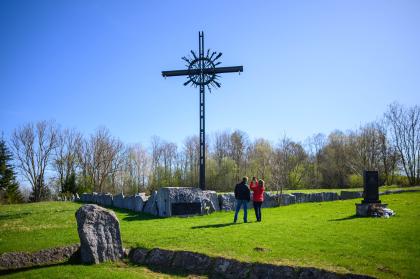The Vaivara Blue Hills Memorial
The Vaivara Blue Hills Memorial is a memorial field dedicated to the battles of the Second World War in the summer of 1944, with a 12-metre composition with a sun cross symbolising an explosion in the middle.
Most likely, the Blue Hills (Sinimäed) were named after the thick spruce forest covering them, which seemed blue when looking from a distance. Going from the west to the east, there are the Tower Hill (Tornimägi, also Hill 69.9 or Kõrgendik 69,9), the Grenadier Hill (Grenaderimägi, also Hell’s Trench Hill or Põrguhauamägi) in the middle and the Orphanage Hill (Lastekodumägi, also Park Hill or Pargimägi) in the east.
The region of the hills is a monument of cultural heritage as a battlefield of the Second World War. The memorial is situated on the western ridge and slope of the Grenadier Hill. According to the designs of the architect Tiit Kaljundi, in 1997–2000, a memorial was established here with a cross, a granite stone edging symbolising the offensive (east–west), and a section of a reconstructed trench that joins the cleared original trench line.
Later, monuments dedicated to the national units of German troops (the 20th Estonian division, brigades of the Walloons and the Dutchmen) were put up in front of the cross and memorial plates were erected to commemorate the old Vaivara cemetery which was the battlefield in 1944.
The beginning of the battles of the Blue Hills is considered to be 26 July 1944, when units of the Red Army reached the Blue Hills, quickly breaking through the German units in front of the Orphanage Hill. This eastern hill took a strong artillery strike, so the battalion of Flemish volunteers suffered great losses. The Red Army began to systematically attack on 27 July. Supported by tanks, the German main defensive line was broken through in several places and by the afternoon, the Red Army had taken most of the Orphanage Hill. There were several attempts to reconquer the hill, but the German troops did not manage to stay there. The same fate befell the 1st battalion of the 47th Regiment of the Estonian Grenadier Divison that attacked the eastern hill from the Vaivara old cemetery on the night between 27 and 28 July under the command of Sturmbannführer Georg Sooden.
On 29 July, nine divisions of the Red Army were put into battle. Tens of thousands of soldiers, 1,680 artillery pieces and 150 tanks were assembled to the breakthrough section. The Red Army pushed on to Grenadier Hill and from there on, briefly to Tower Hill.
Obergruppenführer Felix Steiner, Commander of the 3rd Armoured Division, brought his reserves to the battlefield – dozens of tanks. The Soviet tanks did not expect the counteroffensive, so this allowed the Commander of the 45th Regiment of Estonian Grenadier Divison, Sturmbannführer Paul Maitla, to organise the reconquest of the middle hill.
The Red Army continued its fierce attacks on 30 and 31 August as well, but was no longer able to achieve success. The failure forced the Red Army to regroup its forces. The Supreme High Command of the Red Army demanded that the Germans should be destroyed and Rakvere conquered by 7 August 1944 at the latest. Fresh troops were brought into the battle, and the artillery of the infantry units crushed in previous battles was left in place.
On 2 August, the Soviets again went on a large-scale offensive, shifting the focus of the attack from the Blue Hills to the south to Sirgala. Even though in some sections, the Red Army managed to break through the German defence, they were unable to achieve decisive success at any point.
The front stopped. The Red Army was never able to break through the German defence lines, and the front remained in the Blue Hills until the second half of September when German troops were withdrawn from mainland Estonia. According to the documents, the Red Army units were estimated to have lost up to 8,000 soldiers dead and missing on the Narva front from 24 July to 7 August 1944. There were up to 30,000 wounded. The German units on defence also suffered heavy losses. In total, the losses as dead, wounded and missing were estimated to have reached 10,000. Of these, the losses of Estonian units accounted for about a third of the total losses of the Germans.
Further reading:
